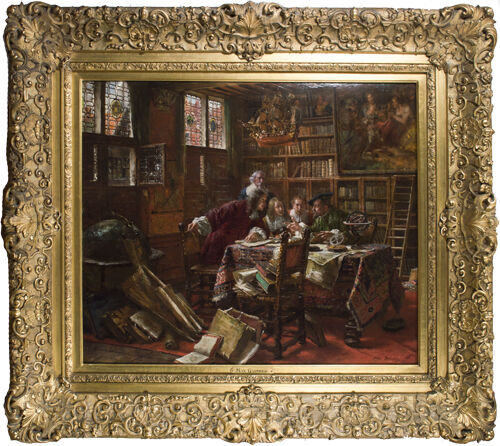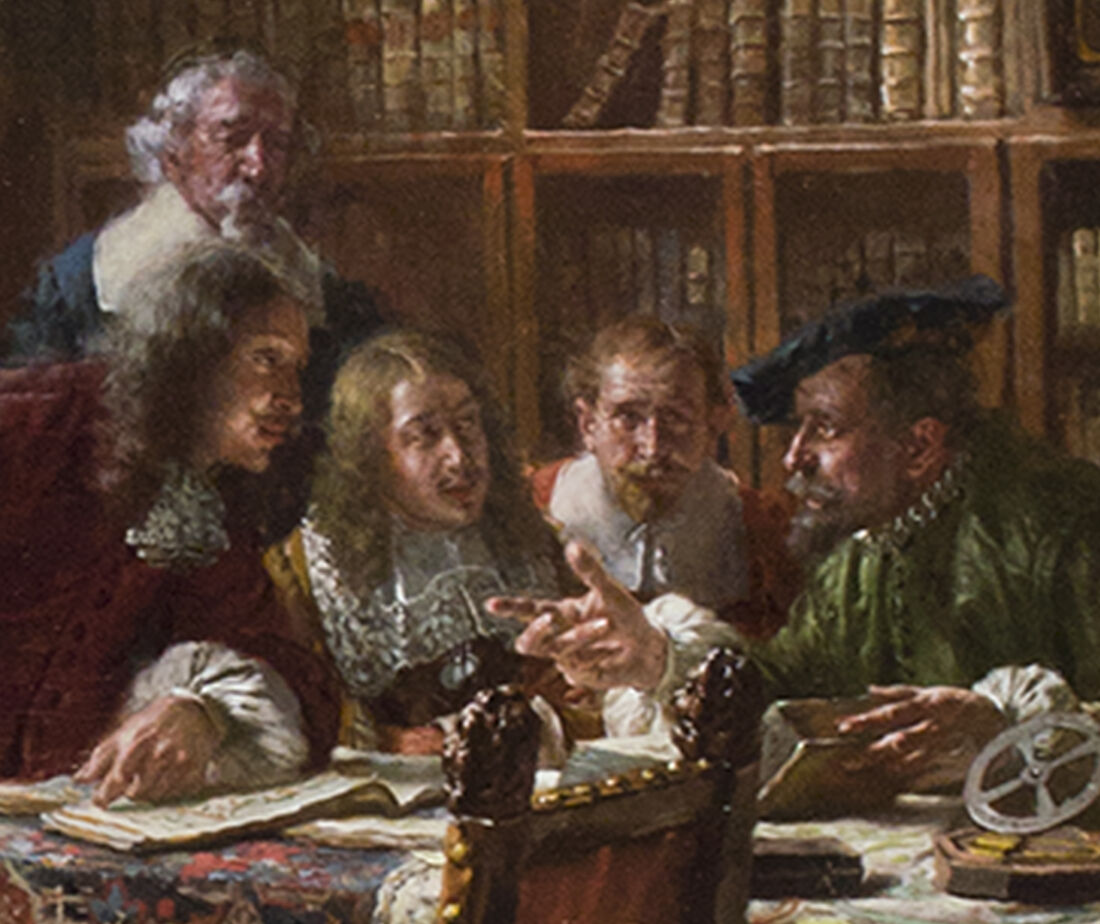Max Gaisser's Planning the Voyage
Max Gaisser's "Planning the Voyage"
A look into a German genre painter's attempt to elevate his craft and advertise his skill.

Max Gaisser, "Planning the Voyage" oil on wood panel, signed lower right; 22 5/8" x 26 3/4" art, 33 5/8" x 7/8" frame; early 20th century
Max Gaisser, born June 22, 1857 in Augsburg, Germany and died July 20, 1922 in Munich, was a traditional genre painter (or a painter of scenes from everyday life) that focused on interior scenes inspired by the Dutch masters of the 16th and 17th century. He received his education in artmaking first from his father, fellow genre painter Jakob Emanuel Gaisser, and then from Ludwig Lofftz at the Munich Academy of Arts. Though his early works, miniature paintings and illustrations for books, did not afford the artist acclaim, it was his attention to detail and design gained during these formative years that made his later, larger interior paintings both meticulous and delightful.
Genre painting during Gaisser’s time was not as well-respected as other painting subjects. In the major art academies and salons at the time, history painting reigned with depictions of religious, mythological, and historic subjects. Below that was the art of portrait painting, since very important and wealthy people often commissioned these works. Below that was genre painting, and lower still was landscape and still life. Artists were frequently relegated to a specific type of painting during their training at the academy; this was thought to improve the quality of each type of artwork by creating specialists instead of giving artists free reign.

Close-up image of a still-life within the painting.
Gaisser was mostly confined to working with genre scenes during his career. However, to show his artistic superiority and talent, he used the background of paintings, including “Planning the Voyage,” to demonstrate his superior skill by painting both portrait paintings and a history painting within his genre scene. This “painting within a painting” technique was frequently used by artists at this time to this end—they were not satisfied with being relegated to a lower genre and thus “rebelled” against their position by painting the higher subjects anyway.

Close-up image of the painting within a painting, a biblical subject.
In “Planning the Voyage,” Gaisser draws upon techniques of well-known Dutch masters, which he studied during his study-travels early in his painting career. Borrowing the warmth and figural skill of Rembrandt van Rijn and the light-filled interior scene from Johannes Vermeer, Gaisser’s painting features five men crowding around a table discussing their next venture. The room is filled with soft light and an immense amount of detail. Gaisser includes books and maps strewn across the composition, suggesting the excitement-filled atmosphere of the figures’ meeting. The hanging model ship is directly in sight of the window, hinting at their desired outcome—to set sail. All five men face towards the viewer instead of surrounding the table, suggesting that one of them had made an exciting discovery and called the others over to see it. This may also be a reference to art history—namely, a reference to Leonardo da Vinci’s “The Last Supper,” in which all twelve disciples and Christ himself sit on the same side of the table.

Close-up of the figures
Gaisser’s references to art history and higher genres of painting elevated his work above general genre painting. “Planning the Voyage” is no exception to this extraordinary effort. It is an exciting subject, painted with expert detail and a warm mood that owes much to the masters of the Netherlands and the rest of Europe. Though Gaisser’s name is not as well-known as Rembrandt or Vermeer, his work has a similar warm and captivating effect.
